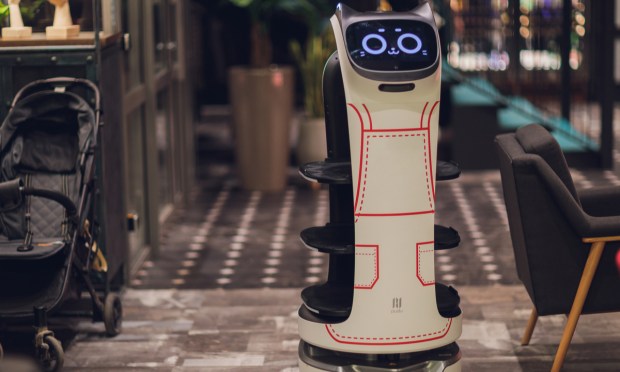Robot Waiters Delight Korea’s Restaurants but Not Its Robotics Firms

Robot waiters from China have become popular with Korean restaurateurs dealing with a labor shortage.
Less enthused about the autonomous servers, the Financial Times (FT) reported Sunday (Aug. 27) are South Korea’s local robotics companies.
According to the report, restaurant owners are struggling to find staff as wages surge. And many customers say they prefer touchless service following the pandemic.
“I don’t have to worry about hiring people anymore,” Seoul restaurateur Kwon Hyang-jin said in an interview with the FT. “It never gets sick or complains about its workload.”
However, executives told the news outlet that country-neutral government programs aimed at encouraging robotics adoption were hurting South Korea’s domestic robot sector.
“We are worried that cheap Chinese robots are dominating our market as it is difficult to compete with them on prices,” said an executive at a top local distributor of domestic robots. “We’re trying to overcome our price weakness with higher-quality robots, but this is not easy.”
While 5,000 robot servers were in use at Korean restaurants last year, up 67% from 2021, 70% of them came from China.
“Restaurant owners prefer Chinese robots because they are cheaper and their functions are just as good as Korean-made ones,” said an executive at the Korean Association of Robot Industry.
“Technology-wise, the Chinese are not behind us,” he added. “But they commercialized server robots earlier than we did and they are more cost competitive.”
The labor shortage facing Korea’s restaurants is not confined to that country. As PYMNTS has written, it’s a situation that’s left many eateries turning to robotics and artificial intelligence (AI) to increase their ability to meet demand.
Among the companies getting into this space are Sweetgreen, Wendy’s and Del Taco, while Chipotle founder and former CEO Steve Ellis is getting into the robotic restaurant space.
In an interview with PYMNTS’ Karen Webster, Krishna Gupta, interim CEO of drive-thru automation tech provider Presto, said voice AI in the drive-thru sector “is evolving quickly” and thus offering restaurant chains dealing with labor shortages and classic drive-thru snags a better way to operate.
“With OpenAI … and large language models in particular, our job is to integrate that into our existing product workflow and make things faster, more personalized, and provide capabilities that frankly weren’t there before,” Gupta said. “All those things matter in the drive-thru.”
A study cited in the PYMNTS/American Express collaboration “Inflation Puts Technology on the Menu for Restaurants” revealed that 78% of restaurant operators do not have enough staff to support customer demand.
In addition, consumers have shown an openness to automation, and may even seek it out when the alternative is shoddy service. Additional research cited in the tracker shows that nearly three-quarters of consumers prefer automation over interacting with staff members in at least one aspect of business.
